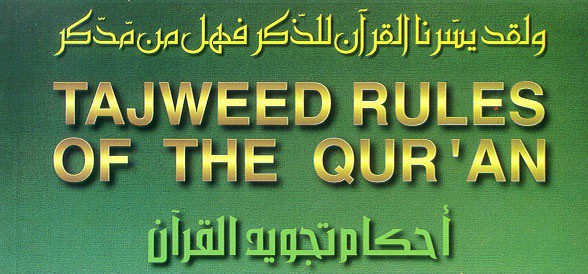Tajweed Rules Part Two

Tajweed Rules Part Two
Hamzah Al wasl + Hamzah Al Qatua
Hamzah Al Qatua
There are two types of Hamzah in the Ouran. They
have different forms and rules.
The letter Hamzah appears in many different forms in the Arabic language, but it is pronounced according to the Harakah above or below the Hamza.
Example: إ- أ- ؤ- ئ- ء
Hamza-tul Oata’ can either be at the beginning, or in the middle, or at the end of a word.
Example: أنتم – سماء
Note:
The Alif and Hamzah are 2 different letters. For Uthmani script, the letter Alif will never have Harakah whilst for Indo Pak script, the letter Alif may have Harakahs. In the latter case, the Alif is pronounced as Hamzah.
Hamzah Al wasl
Hamzah-tul Wasl is pronounced when starting the words, and dropped when continuing.
Hamzah-tul Wasl appears only at the beginning of a word. It has a little saad written on top of Alif ( ). If the reciter starts reciting from a word that begins with Hamza-tul Wasl, then it should be pronounced with Harakah. However, it is not pronounced when joining the word that starts with Hamzah-tul Wasl with the previous word.
Hamzah-tul Wasl can be pronounced with i) Fathah,
- ii) Kasrah or iii) Dhammah according to the following letter.
It is pronounced with a Fathah when it is at the beginning of a noun and is followed by Laam Shamseeyah or Laam Oamareeyah.
Examples: الحمدلله رب العالمين
it is pronounced with a Kasrah when it is at the beginning of a verb and the third letter of the verb has a Fathah or a Kasrah.
Examples: إلا ابليس استكبر
It is also pronounced with a Kasrah in seven nouns in the
Ouran.
For example: إن ابني
It is pronounced with a Dhammah when it is at the beginning of a verb and the third letter of the verb has a Dhammah.
Examples: فمن اضطر
Tajweed Rules Part Two
The Silent & Pronounced Alif
Have you ever noticed some people who seem to be present, can also seem to be
invisible? Or sometimes they’re loud, and at other times they’re so quiet, they’re
not even noticed…? Alif can do the same. Did you ever know? Find out below..
There are seven “alifs” in the Quran that that are sounded when stopping and
silenced when continuing through in recitation. These alifs are signalled by the
round sukoon-like shape above them: ( o )
These seven alifs are as follows:
– All occurrences of the word anaa ( ) أناwhich have this symbol. When stopping,
the alif is sounded for two counts (madd tabee’ee), but when continuing
recitation, the alif is just sounded as a fat-ha. Example,
Read as:
when continuing: ana lakum () أن لكم
when stopping: anaa .. lakum ( )أنا .. لكم
– This rule applies for the following words, in its own respective manner:
[Kahf 38] Read as:
when continuing: laakinna huwa ()لاكن هو
when stopping: laakinnaa .. huwa ( ) لاك ّنا .. هو
[Al-Ahzaab 10] Read as:
when continuing: al-thunoona hunaalika ( )الظنون هنالك
when stopping: al-thunoonaa .. hunaalika ( ) الظنونا .. هنالك
[Al-Ahzaab 66] Read as:
when continuing: al-rasoola wa qaaloo ( ) الرسول و قالوا
when stopping: al-rasoolaa .. wa qaaloo ( ) الرسولا .. و قالوا
[Al-Ahzaab 67] Read as:
when continuing: al-sabeela rabbanaa ( ) السبيل ر ّبنا
when stopping: al-sabeelaa .. rabbanaa ( ) السبيلا .. ر ّبنا
Let’s note this case. Scholars of the Quran have noted that it is permissible to
stop on the word salaasilaa with a sukoon, or to stop on it with two counts on
the alif:
[Al-Insaan 4] Read as:
when continuing: salaasila wa aghlaalan ( ) سلاسل و أغلالاا
when stopping: salaasilaa .. wa aghlaalan ( ) سلاسلا .. و أغلالاا
when stopping: salaasil .. wa aghlaalan ( ) سلاسل .. و أغلالاا
Now let’s note two special cases.
The word qawaareeraa in surat Al-Insaan, verse 16 is never pronounced as a
long vowel when stopping. And it is always pronounced with a fat-ha when
continuing. This also applies for all the occurrences of the word “thamood” (that
contain this silent alif).
[Al-Insaan 15] Read as:
when continuing (after both words): qawaareera qawaareera ( قوارير
) قوارير
when stopping (after the first word): qawaareeraa .. qawaareera ( قواريرا
) .. قوارير
when stopping (after both words): qawaareeraa .. qawareer ( .. قواريرا
) قوارير
Read as:
when continuing: wa thamooda ( ) و ثمود
when stopping: wa thamood ( ) و ثمود
Be careful to never mistake these alifs for the other “normal” ones…
That’s all for this tajweed rule. Too easy.
Tajweed Rules Part Two
The Sifaat of the letters
Sifaat refers to the characteristic(s) of the letter
Definition: the way in which a letter is articulated that differentiates it from others. The purpose of these characteristics is to distinguish the letters that share the same articulation points (makhaarij).
But why do we need sifaat when we already know the origin of the letter (makhraj)?
Makhaarij only provides information as to where the sound of the letter comes from, whereas sifaat provides extra information with regards to the characteristics of the letter in order to produce the correct sound.
This section will further explain this :
Sifaat is of two types:
1.Sifaat WITH opposite (complement)
2. Sifaat WITHOUT opposites (non-complement)
SIFAAT WITH OPPOSITES
Opposite | |
Hems | Jahr |
Shiddah | Rakhaawa |
Itbaaq | Infitaah |
Ithlaaq | Ismaat |
Hams
- Literally means concealment
• Technically means the
continuation of the breath when
pronouncing the letter due to
weakness in its origin, causing
weakness in its reliance on its
makhraj. - The following letters have this
quality:
ف-ح-ث-ه-ش-خ-ص-س-ك-ت
Jahr
- Literally means to be apparent
• Technically means the
discontinuation of the breath when
pronouncing the letter due to
strength in its origin, causing it to
rely greatly on its makhraj
• The rest of the letters have this
quality:
Isti’laa
- Literally means elevation.
• Technically means the elevation of
the back tongue towards the roof of the
mouth when pronouncing a letter.
• The letters that have this quality are:
خ-ص-ض-غ-ط-ق-ظ
Istifaal –
- Literally means lowering or
dropping
• Technically means keeping the
tongue lowered from the roof of the
mouth while pronouncing a letter.
• All letters besides the letters of
Isti’laa have the quality of Istifaal.
Itbaaq –
• Literally means adhesion
• Technically means adhesion of the
tongue to the roof of the mouth while
pronouncing a letter.
• The following letters contain this
quality:
ص-ض-ط-ظ
- Note: these letters also have Isti’laa.
Infitaah –
- Literally means separation
• Technically means keeping the
tongue separated from the roof of the
mouth while pronouncing a letter.
• All letters besides the letters of
Itbaaq contain the quality of Infitaah.
Idhlaq –
• Literally means fluency, purity in
speech
• Technically means the articulation of
the letters with utmost ease from the
sides of the tongue or lips as if they are
slipping away.
• The following letters contain this
quality:
ف-ر-م-ن-ل-ب
Ismaat –
• Literally means desistance
• Technically means the articulation
of the letters with utmost strength and
stability from their makhraj,
without which the letter will not be
articulated.
• All other letters contain this quality
Second: The Permanent Qualities
Without Opposites
Qalqalah
As-Safeer
• Literally means the whistle
• Technically it is the natural occurrence of a whistle like sound emitted while pronouncing the letters.
• The following letters contain this quality:
س-ص-ز
Al-Leen
• Literally, it means softness
• Technically, it means the articulation of the letter from its makhraj with a
natural ease and softness present in the letter.
• The following letters have this quality:
• Waw sakinah (و) with a fatha on the letter before it
• Yaa sakinah (ي) with a fathah on the letter before it.
Al-Inhiraf
• Literally it means to deviate.
• Technically it is the slight deviation of the tongue towards the makhraj of raa while pronouncing laam and towards laam while pronouncing raa.
• This quality is found in only the following two letters:
ر-ل
At-Takreer
• Literally means repetition
• Technically means the trilling of the tongue while pronouncing a letter that causes the letter to be pronounced more than once.
• This is found only in ر
Note: – Unlike other qualities, we must abstain from this quality while
pronouncing this letter.
At-Tafasshy
• Literally means to spread around
• Technically, it is the spreading around of the sound of the letter in the mouth while pronouncing it.
• This quality is found only in: ش
Istitaalah
- Literally means prolongation
• Technically, it is the prolongation of the sound throughout its makhraj ض from its beginning till the end (1.5 to 1.75 beat).
• This is found only in the status of Sukoon or Shaddah for the letter: ض
Tajweed Rules Part Two
Articulations points of Arabic alphabet
Arabic is a unique language in which each letter has a certain point of articulations from where it is pronounced and cannot be pronounced from any other point of articulation. If the letter is not pronounced from the correct points of articulation then the sound of the letter is incorrect. It can then be confused with one of the other letters.
This is why we should be careful when it comes to reciting the Quran, as changing the letter changes the meaning of the Ayah.
Example:
The word قلب means heart, the word كلب means dog. So if you change ق to ك the meaning will change.
What is the purpose of learing the Mal‹haarij of the Arabic language?
The purpose of learning the Makhaarij of the Arabic language is to make the reciter proficient in reciting the Qur’an by observing the correct pronunciation of every letter, without any exaggeration or deficiency. Through this, the reciter can recite the Qur’an according to the way of the prophet peace be upon him who received it from Jibreel who received it from Allah Subhanahu wa Ta’la in the classical Arabic language.
The articulation points
It is the place from where a letter is pronounced, making its sound different from the sound of other letters. Using the right articulation point of a letter is necessary to utter the letter correctly.
The sound:
It is a group of vibrations and waves carried in the air to the human ears.
The letter:
It is a sound that is pronounced from a specific articulation point.
To know the point of articulation of any letter, put a hamzah before the letter. For example if you want to know the point of articulation of the letter ب, put hamzah before it أب .
if the Ouran reader pronounces each letter from its proper articulation point, with all of the letter’s characteristics, and can read each letter properly by itself, and in conjunction with other words, he has then achieved high quality in reading the Ouran.
How do humans produce 28 different sounds in the
Arabic alphabet, using only 2 vocal chords?
The speech system is divided into five major areas. Each letter has one articulation point, which is used to produce the sound of the letter.
Some articulation points have more than one spot which produces different sounds. There are 17 different articulation points to pronounce the 28 Arabic letters and the Madd letters.
For a letter to be pronounced, there has to be a collision of two parts of the speech system. However, this is not the case for the Madd letters, where you will have to create a distance to the colliding parts.
the speech system
The following are the five major areas of the speech system:
- The empty space in the mouth and throat: It has one articulation point for the three letters of
- The Throat: It has three articulation points for six different letters which are pronounced from the deepest, middle, and closest part of the
- The Tongue: It has ten articulation points for eighteen letters.
- The Two Lips: The lips have two articulation points for four
- The Nasal Cavity: It is a large air-filled space above and behind the nose, in the middle of the It is the continuation of both nostrils. There is one articulation point, that of the Ghunnah.
The empty space in the throat and mouth (Al-Jawf)
The Throat
the Tongue
The Lips
The Nasal Cavity
The empty space in the throat and mouth (Al-Jawf)
The empty space in the mouth and throat is a major area and an articulation point at the same time. The three Madd (lengthened) letters originate from this general area, these letters are:
- Waaw Sak inah preceded by a Dhammah
- Yaa Sakinah preceded by a Kasrah
- Alif preceded by a Fathah.
These three Madd letters do not have a specific place that they are pronounced from, unlike all the other letters. Their sound is produced from the point of articulation of the previous letter.
When pronouncing the Alif, the sound should be rising. If the Alif is preceded by a heavy letter, the Alif should be heavy, whilst if preceded by a light letter, it will be
light. Example: باب
When pronouncing the Waaw, the sound should be straight (neither falling nor rising), in addition to circling of the lips.
Example: يفعلون
When pronouncing the Yaa, the sound should be falling, in addition to raising of the middle part of the tongue.
Example: عليم
The Throat
There are three points of articulation in the throat and each point has two letters emitted from therein. Each point of articulation has two spots which produce diHerent sounds.
- The deepest part of the throat
- 2- The middle part of the throat
3- The closest part of the throat (closest to the mouth)
The deepest part of the throat:
ه – ء
These letters are pronounced from the deepest part of the throat which is the furthest away from the mouth and the closest to the chest.
The middle part of the throat:
ع – ح
These letters are pronounced from the middle part of the throat which lies half way in between the beginning and the end of the throat.
The closest part of the throat:
غ – خ
These letters are pronounced from the closest part of the throat which is the beginning of the throat, or the closest to the mouth.
the Tongue
There are ten articulation points for eighteen letters. These ten articulation points are distributed over four areas of the tongue:
1- The deepest part of the tongue:
ق-ك
2- The middle of the tongue.
ج-ش-ي
3- The edges (sides) of the tongue.
ل-ض
4- The tip of the tongue.
ن-ر-ت-د-ط-س-ز-ص-ث-ذ-ظ
The roof of the mouth is divided into 2 parts:
- The hard palate; the top roof area, near the
- The soft palate; deepest part of the roof, near the The tongue touches the gums or the hard or the soft palates to produce different letters.
The Lips
There are two articulation points for four letters.
The first point of articulation is for the ف, the other one is for the ب-م-و.
The bottom edge of the front two upper incisors touches the inner bottom lip.
ف
Circling of the two lips without meeting completely. This Waaw is not the Waaw Madd. و
و
Closing the two lips together.
When pronouncing the م, part of the sound comes from the mouth whilst the other part comes from the nose.
ب
The Nasal Cavity
ن – م
It is a large air-filled space above and behind the nose in the middle of the face. Each cavity is the continuation of one of the two nostrils. There is one articulation point, that of the Ghunnah.
Ghunnah is a characteristic, not a letter. It is a characteristic of Meem and Noon letters.
the previous part
References
1.The Holy Quran .
2. Abdulwahid Hamid “Graded Steps in Quran Reading”MELS-Muslim Education & literary services, Miami, FL. 2001.
3. Hassan Bin Salim,
4. Haroon R. Baqai, “let’s beautify our recitation”- 3rd Edition, Faith Publication.
5.Tajweed Rules


